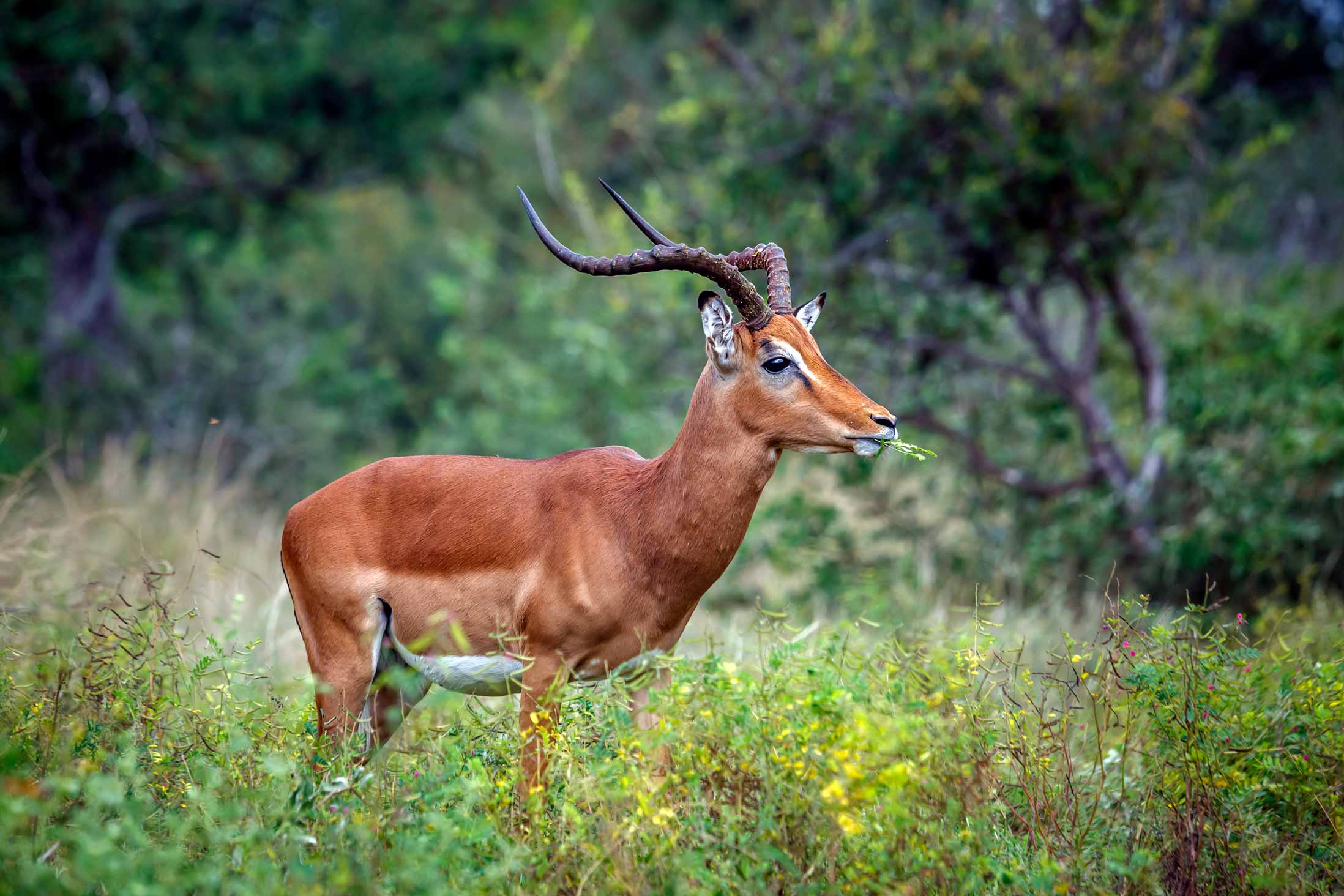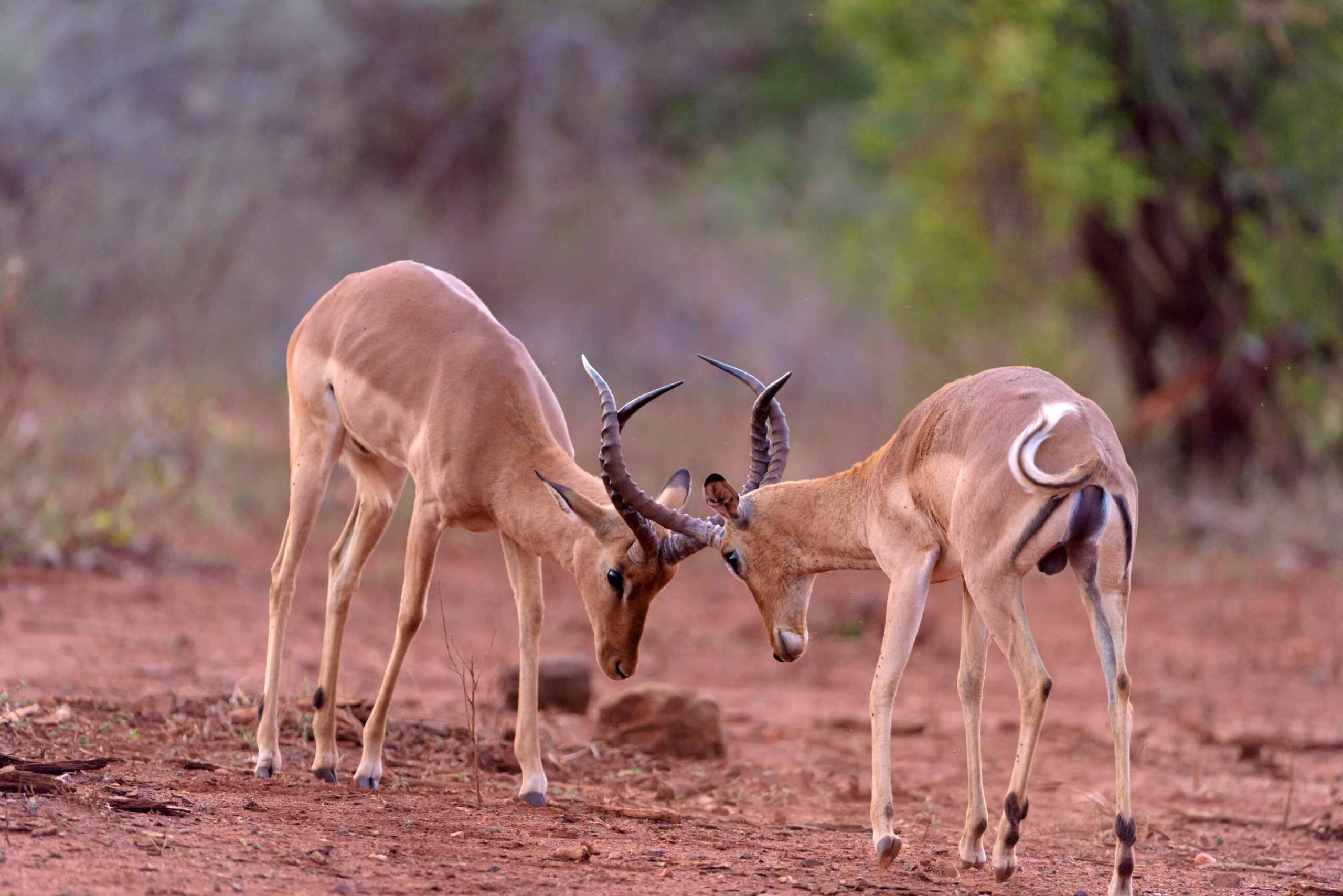Impala
The impala is the sole member of the genus Aepyceros, and within this species, there are two main subspecies: the common impala (Aepyceros melampus melampus) and the black-faced impala (Aepyceros melampus petersi).

Overview
The impala, scientifically known as Aepyceros melampus, is one of Africa’s most iconic and graceful antelopes. Famed for its elegance and agility, the impala is a quintessential part of Africa’s wildlife, often spotted grazing serenely in the vast savannas or bounding across open plains with seemingly effortless grace. With its sleek build, striking reddish-brown coat, and long, curved horns, the impala is an animal that embodies the beauty of African wilderness.
Scientific Classification
- Kingdom: Animalia
- Phylum: Chordata
- Class: Mammalia
- Order: Artiodactyla
- Family: Bovidae
- Genus: Aepyceros
- Species: A. melampus
Description
Physical Characteristics
Impalas are medium-sized antelopes, standing about 75 to 95 centimeters (30 to 37 inches) at the shoulder and weighing between 40 to 75 kilograms (88 to 165 pounds). Their coats are a glossy reddish-brown with lighter underparts, giving them an almost polished appearance in the African sun. Males are generally larger than females and are distinguished by their long, lyre-shaped horns that can grow up to 90 centimeters (35 inches) in length. These horns have a ridged texture and are used both for defense and during mating season for sparring with rival males.
One of the most notable features of the impala is the distinct black markings on the rump, tail, and ears, which serve as a visual cue for other herd members when fleeing from predators. Their slender, athletic build is designed for speed and agility, allowing them to make quick, powerful jumps and sharp turns to evade danger.
Unique Traits
Perhaps the most striking behavior of the impala is its ability to leap remarkable distances. In full flight, an impala can leap as high as 3 meters (10 feet) and as far as 10 meters (33 feet) in a single bound. This not only allows them to escape predators but also helps them to clear obstacles like bushes or small streams during flight. Additionally, impalas are capable of making sudden, sharp turns mid-air to confuse predators, showcasing their incredible agility.
Another unique trait is the impala’s ability to switch between grazing and browsing, depending on the season. This adaptability allows them to thrive in a range of environments, from dry savannas to woodland areas, where food sources can vary drastically throughout the year.

Behaviour and Diet
Social Structure
Impalas are social animals that typically live in groups. During the dry season, females and their young form large herds that can number up to 100 individuals. This social structure offers protection from predators, as more eyes and ears are available to spot danger. Males, however, tend to form bachelor groups or live solitary lives, except during the breeding season when they compete for dominance over territories and access to females.
Dominant males establish territories during the rut (mating season) and engage in intense battles with rivals to maintain control. These fights are not usually fatal but involve the locking of horns and displays of strength. Once a male has secured a territory, he will fiercely defend it, herding any females that enter his domain.
Diet
Impalas are herbivores with a varied diet that shifts based on seasonal availability. During the wet season, when grass is plentiful, impalas primarily graze on fresh, tender grasses. In the dry season, when grass becomes scarce, they switch to browsing, feeding on leaves, shoots, fruits, and even bark. This dual feeding strategy gives them a significant advantage over other antelope species that rely solely on grazing or browsing, allowing impalas to survive in regions with fluctuating food supplies.
To meet their water needs, impalas often stay close to water sources but can go for days without drinking if necessary, obtaining moisture from the food they consume.
Reproduction and Lifespan
The impala’s breeding season, known as the rut, typically occurs at the end of the wet season (April to June), when food and water are abundant. During this time, males compete fiercely for control over territories and the right to mate with females. These territorial battles can be intense, with males using their horns to spar with rivals in displays of strength and dominance.
Once a male secures a territory, he attempts to mate with as many females as possible. Female impalas have a gestation period of about six to seven months, after which a single calf is born, usually in the early months of the wet season when food is plentiful. The timing of the birth maximizes the calf’s chances of survival.
Newborn impalas are well-developed at birth and are able to stand and move within minutes. However, for the first few days, they remain hidden in tall grass or bushes while their mothers feed nearby. After a few weeks, they join the larger herd and begin to interact with other young impalas.
The average lifespan of an impala in the wild is around 12 to 15 years, though many do not reach this age due to predation by lions, leopards, cheetahs, and wild dogs.
Habitat and Geographical Distribution
Impalas are found across eastern and southern Africa, thriving in a wide variety of habitats ranging from savannas and woodlands to floodplains and grasslands. They are especially common in protected national parks and game reserves, where they are among the most frequently seen animals.
Countries where impalas are found include:
- Kenya: Impalas are a common sight in the Maasai Mara and Amboseli National Park.
- Tanzania: Serengeti National Park is home to large herds of impalas, where they coexist with other herbivores like zebras and wildebeest.
- Botswana: The Okavango Delta offers an ideal environment for impalas, with its mix of floodplains and savannas.
- South Africa: Kruger National Park is one of the best places to see impalas, with thriving populations that support the park’s predator species.
- Namibia: The black-faced impala, a subspecies, is native to parts of Namibia and can be found in Etosha National Park.
- Uganda – Impalas can be seen in Uganda’s Queen Elizabeth National Park and Lake Mburo National Park.
- Zambia – The species thrives in Zambia’s South Luangwa National Park and Lower Zambezi National Park, where the habitat is ideal for both grazing and browsing.
- Zimbabwe – Impalas are common in Zimbabwe’s Hwange National Park and Mana Pools National Park along the Zambezi River.
- Mozambique – Impalas inhabit Gorongosa National Park and other protected areas in Mozambique.
- Malawi – Impalas are found in Malawi’s Liwonde National Park and Majete Wildlife Reserve.
- Angola – Some populations of impala are present in Angola’s wildlife-rich areas.
- Eswatini (Swaziland) – Impalas are found in Mlawula Nature Reserve and Hlane Royal National Park.
- Rwanda – Impalas inhabit Akagera National Park in Rwanda.
Impalas prefer areas with plenty of cover, such as woodlands and grasslands near water, but they are highly adaptable and can survive in regions with varying rainfall and vegetation types.
Conservation
Impalas are classified as “Least Concern” by the International Union for Conservation of Nature (IUCN), largely due to their widespread distribution and stable population numbers. However, local threats do exist, including habitat loss due to agricultural expansion and human development. In some regions, impalas face the threat of poaching for bushmeat or horns.
In Namibia, specific conservation programs have been implemented to protect the black-faced impala, whose population is more vulnerable due to a more limited range.
Facts
Interesting facts about The impala (Aepyceros melampus).
Impalas are renowned for their leaping ability, able to jump over 10 meters (33 feet) in distance and 3 meters (10 feet) in height.
Unlike many antelopes that specialize in grazing or browsing, impalas can switch between the two depending on the season, making them highly adaptable.
An impala can reach speeds of up to 60 km/h (37 mph) when fleeing from predators.
The black stripes on an impala’s rump are thought to help herd members follow each other during rapid escapes from danger.
Male impalas engage in intense battles for territory during the breeding season, often locking horns in dramatic duels.
Female impalas form large herds during the dry season, increasing their chances of detecting predators.
Impalas use a variety of vocalizations, including snorts and grunts, to alert the herd to danger.
Although they prefer to stay near water, impalas can survive for extended periods without drinking by extracting moisture from plants.
Newborn impalas are hidden by their mothers for the first few days of life to protect them from predators.
Impalas are one of the most abundant antelope species in Africa and can be found in countries across eastern and southern Africa.
Other Animals
Explore fauna in Africa.






